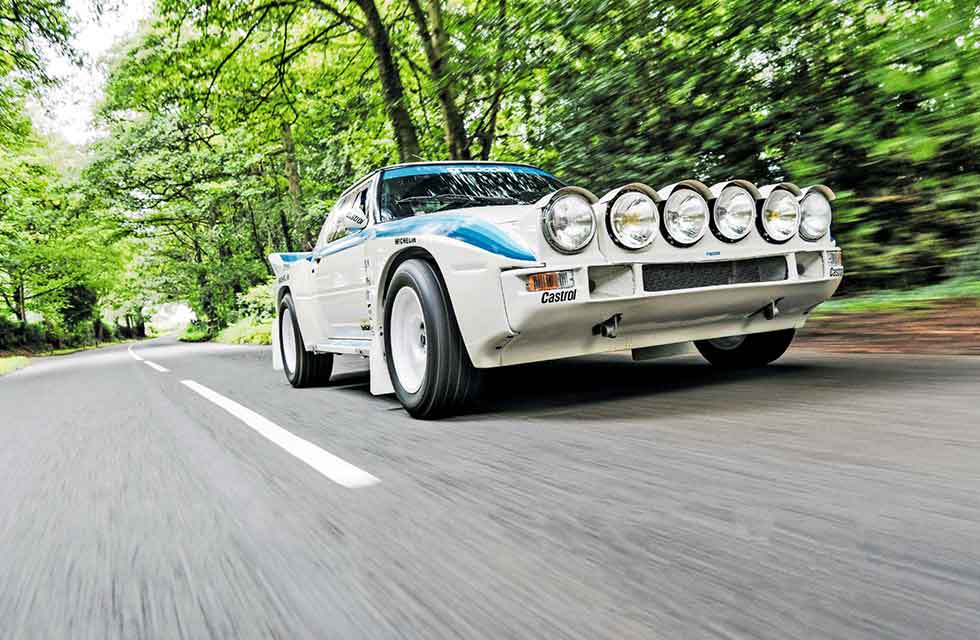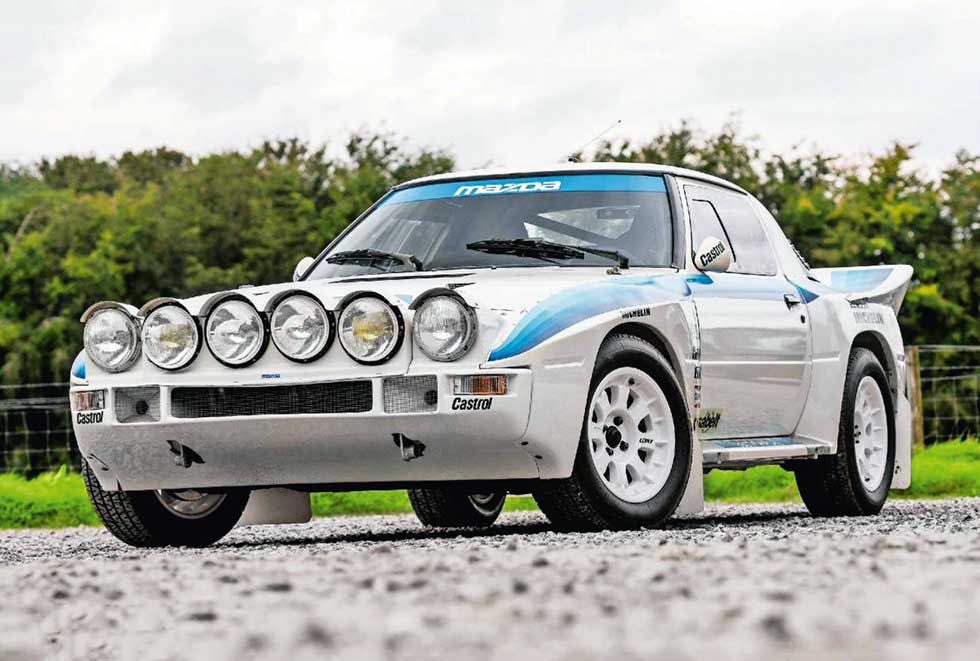
Flat-out in Group B rallying’s perpetual runner-up: Mazda’s screaming RX-7 Evolution. This Mazda RX-7 Evolution was constructed for Group B rallying, whose cancellation meant it never once saw action. Until today… Words Ross Alkureishi. Photography Jonathan Jacob.
In A Rotary Time Warp
On the road in Group B’s forgotten great: Mazda RX-7 Evo
Mazda RX-7 Group B warrior driven on the road
The noise – oh my, the noise. Before he got a job talking about more important things, comedian Paddy McGuiness found himself a gig fronting a Saturday night television dating show in which his catchphrase revolved around variations of ‘let the crown see the jewels’ and ‘let the hanky see the panky’, etc. Well, in this case, it’s let the exhaust see the baffle. Or not.

Technician Josh Gray is warming up the Mazda RX-7 Evolution’s 13BWankel powerplant and even seasoned workshop professionals, used to all manner of exotica, can’t help but crowd around as he blips the throttle. It’s part Group B glow – rallying in its most wild, unrestrained and legendary of forms – and part acoustics, but mostly the latter. Think the hollow metallic starting clatter from the racing cans of a Ducati Desmosedici GP7, and you’re not far off.
‘The rack-and-pinion steering leaves my hands in no doubt about the chassis’ intentions’
As the air continues to pulsate in rhythm with the exertions of Josh’s right foot, I take in the Mazda’s brutish outline. Look past the rally addenda – bonnet-mounted light cluster, wide polyester wings and a rear spoiler that’d do justice to a vintage hydroplane are the most prominent – and you can see the attractive underlying outline of its first generation (FB) Mazda RX-7 origins. Of course anyone au faitwith that particular rallying category and its combatants – Peugeot T16, Audi Quattro, Metro 6R4, Renault 5 Turbo et al – will know that while the external aesthetics resembled those of their production brethren, in reality the mechanicals weren’t just aworld away. Theywere in the next galaxy.
‘I become a human slinky as I re-distribute a surplus six inches of height’

Visually there’s enough there for me to recall standing as a boy in a West of Scotland Mazda showroom circa 1985, drooling over a standard production variant at first sight and trying to persuade my father to adopt a ‘to hell with it’ attitude and buy it. Much to my chagrin, he opted for the sensible 626GLX family option.
The sudden cessation of sound brings me out of my reverie. Josh climbs out and hands me a peculiar J-shaped key. It’s part Allen key, part Cluedo piece – it was Mr Carlsson, in the forest, with the tyre iron. ‘You’re a lucky boy,’ he says. I know – one look at the delivery mileage on this car’s odometer shows that it’s barely been driven. Oh, and it’s just been road-registered.
Straddling the roll-cage’s side impact bar, I adopt a ballet-style pointing-toes movement as I slide my right foot into the footwell; that downward movement produces enough momentum and I’m in, slow-motion scissor-kick style. Owner David Sutton carries out a mirrored manoeuvre into the passenger seat as he joins me. ‘It’s such a fierce thing and sounds fantastic just going in and out of the garage, but I’ve never driven it,’ he says. ‘With next to no miles on the clock, should you, or shouldn’t you?’
Mazda began constructing cars to basic Group B specification in February 1984 – differing from the old Group 2 car by the addition of rack and pinion steering and a larger, more powerful 2616cc version of the 13B engine – but switched to the more specialised competition-only Evolution variant three months later. Only 20 of these high-performance versions were required for homologation, although just seven were fully constructed in period. Mazda itself has confirmed that this car, chassis number MRTE 00019, was built in 1985 and today, it’s like stepping into a time machine. The level of originality is staggering, with intercom cables still tie-wrapped and clipped for a day that never came.
The driver’s seat position is bolted in place – although it could be moved further back – and I have to become a human slinky as I do my best to re-distribute a surplus six inches of height. Inside, a touch of carpet on the transmission tunnel is the only real attempt at road-car luxury. There’s little by way of sound deadening, with thick braided fuel lines running centrally to the huge bespoke alloy fuel tank mounted just behind my elbows, leaving me in no doubt that this car is purely and simply a high-velocity missile. I insert and turn the key. The cabin atmosphere heightens as the electrics come online, and I press the centrally mounted starter button. The huge Weber 48IDA carburettor catches with a clatter before hardening to resonate through my core – I feel like I’ve been transported into the heart of a wasp’s nest that’s just received a hefty thump with a stick. I’ll state it again, oh my…
Mazda homologated two gearboxes and this is the dogleg first- gear unit. The clutch engages with a light movement, I slot the stubby wooden lever into first and we’re off out into the real world. I pull out onto an A-road, squeeze the throttle and first impressions are of the magnificently smooth nature of power delivery – the twin-rotor engine just wants to spin and spin.
After a relatively sane couple of acclimatisation miles, I sense a car looming behind me – all mirrors are for display purposes only because I can’t see Bo never mind Diddley. Time to get harder on the power. The rear squats and its pared-down 990 kilograms is thrust forward at an incandescent rate, accompanied by a unique off-kilter, high-pitched rotary scream – forget insect analogies, this is fox in full-on berserker mode in a chicken coop.
The rev counter reads to 12,000rpm and those examples driven in competitive anger spun happily to 10,000 of those, but because this engine’s technically still being run in I’m being considerably circumspect about when to shift. That said I’m fairly sure our tailgater is no longer there. What a rush.
With 300bhp it’s far removed from a standard naturally aspirated RX-7’s 115bhp (although the Japanese-market ‘Savanna’ Turbo made 163bhp), but accessing its 196lb ft of torque still requires working the gearbox hard; I’m glad I had my Shredded Wheat this morning. It’s a notchy unit with a short throw, but requires a decent amount of heft to fully engage.
Out in the Cheshire wilds now and through a series of tight bends, its combination of sharp steering and firmly planted rubber sees it execute lightning changes of direction. With an engine mounted slightly nearer to the bulkhead for improved weight distribution, it’s lovely and balanced. At the next corner I push harder and feel the rear end wanting to join the party, just begging for a little flick of the wrist, but today’s not the day, and this isn’t the place for old-school rear-wheel-drive rally antics, no matter how temping.
While the rest of the rally scene had departed for a turbocharged, four-wheel-drive world, Mazda continued to plough a conventional path, engine aside of course. The noise of the RX-7 as I blare under the canopy of a tree-lined road is transformative, and it’s easy to feel like Ingvar Carlsson hurtling forward to collect third on the 1985 Acropolis Rally.
Despite having a fairly inauspicious WRC record, the FB RX-7 proved successful in other motor sport fields. Win Percy piloted one to both the 1980 and 1981 British Touring Car Championship titles, while in the North American IMSA series it dominated the GTU (GT under 2.5-litres) class in the early Eighties. It also had rally success in prototype four-wheel-drive form, storming to the 1981 SCCA Pro Rally title in the hands of New Zealander Rod Millen. Following his triumph, and in order to make a more serious attempt on the WRC, Mazda Rallye Team Europe was formed. Stationed at the company’s Brussels base, MRTE came under the leadership of team manager and driver Achim Warmbold.
MRTE’s first WRC entry was the 1983 Acropolis Rally, with Warmbold placing 15th and Harri Toivenen finishing 17th. On 1 February 1984, the RX-7 became the first rotary-engined car to be homologated for Group B. Three months later MRTE followed that up with the Evolution model; in came a raft of lightweight panels, re-jigged weight distribution, a rear-wing-mounted oil cooler, a rear-mounted dry sump tank and parallel rear axle links.
First-year highlights included a ninth-place finish for Warmbold on the Acropolis Rally and a win for Carlsson in the European Championship’s Polish Rally. On the 1985 Swedish Rally, Carlsson achieved eighth place – the highest finish on the snowy event for a two-wheel-drive vehicle. Better still was to come on that year’s Acropolis, with Carlsson taking a highly impressive third place behind a Peugeot 205 T16 and Audi Sport Quattro. Rod Millen was then invited over from the States and he finished ninth on the RAC Rally, with Carlsson one place behind. That season Mazda finished tenth overall in the World Championship, with the Swede 16th in the driver’s standings. Two European Championship second places in 1985 – one for Marc Duez on the Boucles de Spa and another for Carlsson on the Skoda Rally – would prove to be the finale for the RX-7, before the awful May fatalities in Corsica heralded the beginning of the end for Group B rallying.
As I continue to enjoy the car in the present day, David and I hold a conversation conducted at a level just shy of shouting. ‘I’ve always been a Group B nut,’ he admits. ‘I’m not a collector – I suspect I’d get bored of hanging on to things – but quite enjoy refreshing cars, and enjoying them for a couple of years. Having owned numerous mid-engined Group B cars including a Metro 6R4 and Renault 5 Turbo 1 – both of which I ran on track albeit non-competitively – it’s extreme cars like this that I love the most.
‘I heard about two works Mazdas for sale in Norway; this one appealed because it was such a timewarp. It was just as it was sitting there in MRTE in 1985, waiting for a moment of glory that never came.
‘Everything about the car is so original. It didn’t have harnesses or seats – I had to do a lot of research to establish what they were because they were unbranded. There weren’t even any rally decals; they were in a pack, but not applied to the car. ‘After carrying out a gentle re-commissioning – including engine testing, replacing the fuel pumps and servicing the carburettor – I lent it to Mazda’s UK Heritage Centre, where it was displayed for two years.’
My own Group B rotary experience is coming to an end, so I turn round in the next village, instantly receiving an indignant look from an elderly resident as I conduct perhaps the loudest three-point turn in history; it’s absolutely impossible to do anything quietly in this car. In less than ten minutes I’ve gone from feeling like Ingvar Carlsson on a wild charge, to McSheepish on manoeuvre. As I accelerate away, and then ease off the throttle as the junction appears, the flames no doubt now exiting the straight-through exhaust pipe will be doing little to temper her mood. I best not return.
The journey back to base is conducted at a relatively relaxed pace, punctuated only by inevitable and intoxicating heavy bursts of acceleration. The manner in which the RX-7 conducts itself, the rack-and-pinion steering leaving my hands in no doubt as to the chassis’ intentions as it loads up, instils confidence and goads me into pushing on in the next corner.
As we pull up, it’s handbrake on and I cut the power. I share a handshake with David and thank him for allowing me to break the car’s mileage cherry. ‘You’ve driven it further than I have,’ he says. Not only that, I’ve joined a very small band of driver’s to sample a Group B RX-7 Evolution.
Another who has is David Paveley, MD of Llandudno Junction based specialist Group B Motorsport. His company restored MRTE 00020, the car in which Ingvar Carlsson achieved third place in on the ’85 Acropolis Rally. ‘The Group B Mazda RX-7 was built to a budget,’ he explains. ‘It didn’t boast the bespoke parts or the development of other manufacturer’s cars. The gearbox and rear axle were parts sourced from other cars in the range globally, rather than subcontracted to specialist manufacturers as was the case with the T16 or RS200, but on the flipside it was a purpose built sports car to begin with so the centre of gravity and weight distribution were already really good. A lack of investment was the car’s main weakness, but it was strong and reliable, and this made it effective because it was a good points scorer.’
Countering unsubstantiated rumours of four-wheel-drive, period Mazda sources state that the following season’s evolution would have included a sequential gearbox, lighter rear axle and electric power steering and fuel injection. Group B Motorsport recently built one of the original bodyshells to that exact specification. ‘I qualified it into the top 20 run-off at the 2014 Goodwood Festival of Speed, and when you are in a line that includes F1 and modern WRC cars, you know the car carries speed well.’
Despite a relatively limited number of miles today, that’s something I’ve just had a thoroughly compelling insight into. The RX-7 Evolution may have been an underfunded Group B underdog, and its mechanicals perhaps not quite as ‘in the next galaxy’ as I first imagined, but it was one that most definitely punched above its weight.
Having now decided to sell this car, David has completed the process of having it road-registered like it would have been had it made it into service, so the next owner has an extra element of choice in answering his earlier ‘should you or shouldn’t you’ question about using it.
I know what my answer would be.
Gearbox is a traditional five-speed manual, albeit with a dogleg first for quicker rowing between the all-important second and third gears when you’re in attack mode. It never made it onto the special stages, but this Mazda was equipped to tackle the darkest corners of the Acropolis Rally’s Peloponnisos region RX-7 was naturally aspirated and carb-fed, while rivals employed fuel injection and turbocharging Contortionist Ross savours his every last multiplication of the odometer reading. The RX-7’s large rear window pane was remade in Perspex to save weight. Huge faired-in rear spoiler helps push the driven wheels into the tarmac – or whatever other surface they encounter.
This car is now for sale at Trevor Farrington (trevorfarrington.co.uk)
RALLYING MRTE 00020, THE ‘ACROPOLIS’ RX-7
After his company restored the RX-7 Evolution that Ingvar Carlsson drove to third on the Acropolis, David Paveley rallied it on the 2011 Boucles De Spa Rally. ‘Its outstanding strength was its handling,’ he recalls. ‘It was incredibly fast on smooth tarmac and not bad on the loose, with great traction. Corner speed was very impressive, it stopped really well and although the engine was not as powerful as the figures published, it revved very freely and pulled well from slow speed corners. It also sounded amazing – you have to remember it was still carburetted whereas the competitors were on injection with turbochargers.’
Despite being up against a number of period rival Audi Quattros, Paveley set a fastest stage time on the rally. ‘It proved that the car was not a one-hit wonder. The engine receives a bad press, but set up correctly it’s fine. The housings are rare and have totally different ports to the road car so getting the power requires a lot of porting work. In Group B configuration it’s hard work because the gearbox was agricultural, but it’s still a rewarding car to drive. On the limit it’s very reassuring, I always felt I had a bit more in reserve if I needed it!’
1985 Mazda RX-7 Evolution Group B rally car
Engine 2616cc twin-rotor Wankel 13B, Weber 48IDA carburettor
Max Power 300bhp @ 8200rpm
Max Torque 196lb ft @ 7500rpm
Transmission Five-speed manual, rear-wheel drive, limited-slip differential
Steering Rack and pinion
Suspension Front: Independent, MacPherson struts, parallel links, Bilstein telescopic dampers; Rear: Live axle, coil springs, parallel links, Bilstein telescopic dampers
Brakes Girling discs all round, dual circuit with servo and quick release pads
Weight 990kg (2178lb)
Performance 0-60mph: depends on gearing
Top speed: depends on gearing
Cost new n/a
Asking price £169,500






